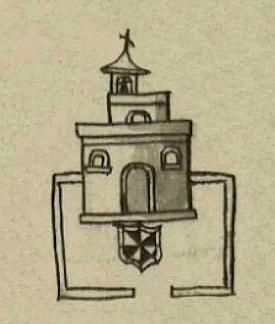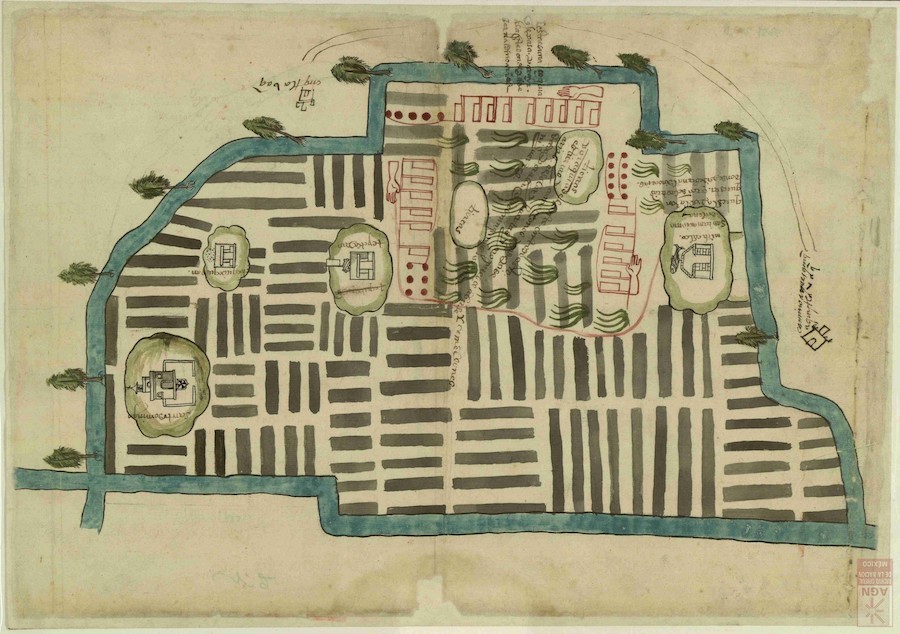teopantli (T2681:6:2r)
This simplex glyph, showing a good deal of Spanish cultural influence, can be translated as “the church of Santo Domingo,” so we have chosen to call it a teopantli (church or temple in Nahuatl). It is found on a later-sixteenth-century pictorial manuscript having to do with Cuitlahuac (or Cuitlahuacan), Chalco. It consists of a black and white image of a church within its walled, rectangular atrio, in a frontal view. The church has a Dominican crest attached to it. The church also has three levels including a bell tower with a cross on top, an arched doorway, and three windows. Some of the walls show shading, which gives it a three-dimensionality. The church and atrium have a considerable amount of symmetry.
On the pictorial manuscript where it is found, the church is situated on what may be either an island or a stylized rendition of a more traditional tepetl glyph with green and brownish shading surrounded by chinampa agricultural plots and an alphabetic gloss that says “Santo Domingo” (see the historical contextualizing image). Unfortunately, the Spanish and Nahuatl documents related to this pictorial do not indicate what the local Nahua population would have called the church a teopan, teopantli, iglesia, or perhaps convento, adopting loanwords). Whatever the case, the compound glyph here shows how indigenous artists were adapting glyphic communication almost sixty years after the arrival of Spaniards in Mexico.
Robert Haskett
This simplex glyph appears on a pictorial manuscript submitted by Indigenous petitioners from the pueblo of Cuitlahuac, Chalco, sometime before March 24, 1579, when a canoe-borne investigation was carried out of a chinampa (artificially constructed raised field in the shallow waters of a laguna) near the sujeto (dependency) of Santa María Magdalena (also called an estançia). The community’s land tenure was being threatened by an effort of a man named Bartolomé Arias to gain a grant of this property from the viceregal authorities (an effort that ultimately failed). While Arias and several witnesses who supported him claimed that the parcel was filled with grass, used by him to pasture horses, witnesses for Santa María Magdalena and Cuitlahuac asserted that it was customarily planted with maize, chili, and other agricultural products. While there is a short Nahuatl-language petition included among the folios of this case (14r), it does not mention specific crops, and it uses the loan solar (lot) rather than chinamitl or chinampa to describe the agricultural parcel. On the other hand, a Spanish-language report of a second canoe-borne investigation (fol. 18r) states that the parcel in question is what “los indios llaman chinampas” (“what the Indigenous people call chinampas”) and includes a brief description of how they were built.
Robert Haskett
Santo domingo
Santo Domingo
Robert Haskett
1579
Robert Haskett
place glyph, church, iglesia, convento, chinampa, teopancalli

teopan, temple, church, https://nahuatl.wired-humanities.org/content/teopan
teopan(tli), church (in this case, of Santo Domingo), https://nahuatl.wired-humanities.org/content/teopantli
la iglesia
Robert Haskett
Single-page codex, Archivo General de la Nación, México, Ramo de Tierras Vol. 2681, Exp. 6, Fol. 2r.
The Archivo General de la Nación (AGN), México, holds the original manuscript. This image is published here under a Creative Commons license, asking that you cite the AGN and this Visual Lexicon of Aztec Hieroglyphs.


